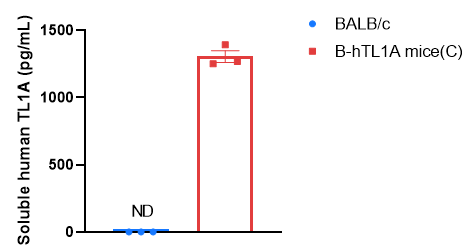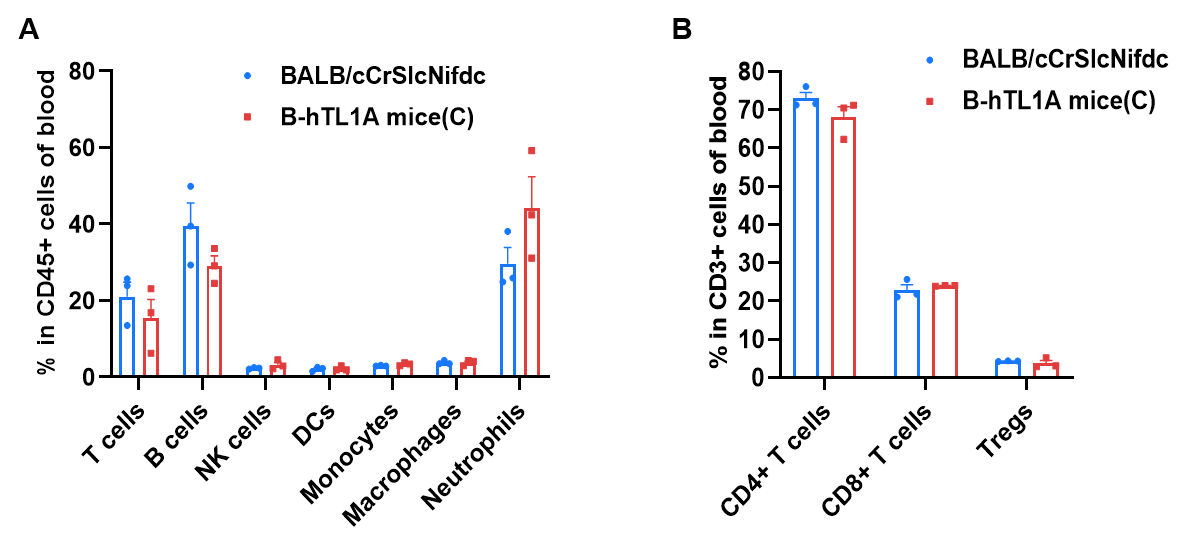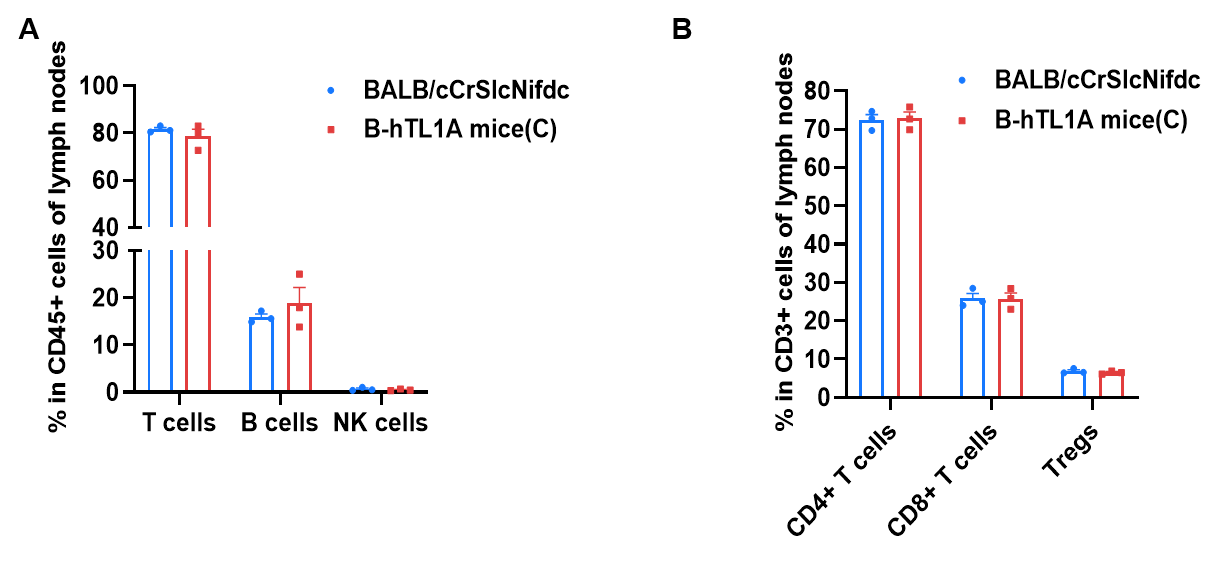
BALB/cCrSlcNifdc-Tnfsf15tm1(TNFSF15)Bcgen/Bcgen • 113035
Gene targeting strategy for B-hTL1A mice(C).The exons 1-4 of mouse Tl1a gene that encode extracellular domain were replaced by human counterparts in B-hTL1A mice(C). The genomic region of mouse Tl1a gene that encodes transmembrane domain and cytoplasmic portion was retained. The promoter, 5’UTR and 3’UTR region of the mouse gene were also retained. The chimeric TL1A expression was driven by endogenous mouse Tl1a promoter, while mouse Tl1a gene transcription and translation will be disrupted.

Strain specific analysis of TL1A gene expression in wild-type (WT) mice and B-hTL1A mice(C) by RT-PCR. Mouse Tl1a mRNA was detectable only in lung and colon of wild-type BALB/c mice (+/+). Human TL1A mRNA was detectable only in homozygous B-hTL1A mice(C) (H/H) but not in wild-type BALB/c mice (+/+) .

Soluble TL1A expression analysis in B-hTL1A mice(C) by ELISA. Bone marrow derived dendritic cells (BMDCs) were produced by culturing the bone marrow from wild-type BALB/c mice (+/+) and homozygous B-hTL1A mice(C) (H/H), which were stimulated with LPS in vitro. After stimulation, the supernatants were collected and the levels of soluble TL1A were measured using a species-specific human TL1A ELISA kit (R&D, DY1319-05). Soluble human TL1A was exclusively detectable in homozygous B-hTL1A mice(C) but not wild-type BALB/c mice. Values are expressed as mean ± SEM. ND: not detectable.

Frequency of leukocyte subpopulations in spleen by flow cytometry. Splenocytes were isolated from wild-type BALB/cCrSlcNifdc mice and homozygous B-hTL1A mice(C) (Female,7-week-old, n=3). A. Flow cytometry analysis of the splenocytes was performed to assess the frequency of leukocyte subpopulations. B. Frequency of T cell subpopulations. Frequencies of T cells, B cells, NK cells, DCs, neutrophils, monocytes, macrophages, CD4+ T cells, CD8+ T cells and Tregs in B-hTL1A mice(C) were similar to those in BALB/cCrSlcNifdc mice, demonstrating that humanization of TL1A does not change the frequency or distribution of these cell types in spleen.Values are expressed as mean ± SEM. Significance was determined by two-way ANOVA test. *P < 0.05, **P < 0.01, ***P < 0.001.

Frequency of leukocyte subpopulations in blood by flow cytometry. Blood cells were isolated from wild-type BALB/cCrSlcNifdc mice and homozygous B-hTL1A mice(C) (female, 7-week-old, n=3). A. Flow cytometry analysis of the blood cells was performed to assess the frequency of leukocyte subpopulations. B. Frequencies of T cell subpopulations. Percentages of T cells, B cells, NK cells, DCs, monocytes, macrophages, neutrophils, CD4+ T cells, CD8+ T cells and Tregs in B-hTL1A mice(C) were similar to those in BALB/cCrSlcNifdc mice, demonstrating that humanization of TL1A does not change the frequency or distribution of these cell types in blood. Values are expressed as mean ± SEM.

Frequency of leukocyte subpopulations in lymph nodes by flow cytometry. Leukocytes were isolated from wild-type BALB/cCrSlcNifdc mice and homozygous B-hTL1A mice(C) (female, 7-week-old, n=3). A. Flow cytometry analysis of the leukocytes was performed to assess the frequency of leukocyte subpopulations. B. Frequencies of T cell subpopulations. Percentages of T cells, B cells, NK cells, CD4+ T cells, CD8+ T cells and Tregs in B-hTL1A mice(C) were similar to those in BALB/cCrSlcNifdc mice, demonstrating that humanization of TL1A does not change the frequency or distribution of these cell types in lymph nodes. Values are expressed as mean ± SEM.

TNBS solution was instilled into the colon lumen of B-hTL1A mice(C) (female, 8-10 weeks-old, n=8). The control group (Sham) received intrarectal injections of PBS. The treatment groups received anti-human TL1A antibody Tulisokibart (20 mpk, provided by WuXi AppTec), anti-human TL1A antibody Afimkibart (20 mpk, provided by WuXi AppTec), anti-human TL1A antibody Duvakitug (20 mpk, provided by WuXi AppTec). Body weight and DAI score were recorded daily. On day 6, the mice were sacrificed, and colon length and weight were recorded. Colon tissue was later used for H&E staining. (A) Body weight change. (B) DAI score. (C) Colon Index. (D) Pathological score. An acute colitis disease model induced by TNBS was established in B-hTL1A mice(C), and the administration of the anti-human TL1A antibodies Tulisokibart, Afimkibart and Duvakitug efficiently improved TNBS-induced acute colitis. The results indicate that B-hTL1A mice(C) are a powerful tool for assessing the in vivo efficacy of anti-human TL1A antibodies. Values are expressed as mean ± SEM. *p<0.05, **p<0.01, ***p<0.001, ****p<0.0001 versus Vehicle, ANOVA.
Note: This experiment was conducted by WuXi AppTec using in B-hTL1A mice(C).